
Lake Simcoe Science
Invasive Mussels
Uninvited Lake Dwellers
In the past 200 years close to 150 species of foreign plants and animals have established themselves in the Great Lakes Region.
The first foreign species introduced in Lake Simcoe was the common carp, which escaped from a Newmarket fish pond in 1896. Since then, 15 foreign species have colonized the lake, displacing native plants and animals.
Invasions can happen intentionally through dumping imported aquarium plants and animals into rivers, lakes and streams, and unintentionally, when carried by contaminated boats and trailers, on fishing gear, or the use of illegal live bait.
Common invasive species in Lake Simcoe
Three common species found in Lake Simcoe include the round goby (left), common carp (middle) and Eurasian watermilfoild (right).

Zebra and Quagga Mussels
A couple of the most well-known “invaders” to Lake Simcoe are zebra mussels and quagga mussels.
Native to the Caspian-Black Sea region of Eurasia, they arrived in the Great Lakes in 1988, carried in the ballast water of container ships. By 1995, zebra mussels had established themselves in Lake Simcoe, followed by quagga mussels in 2004.
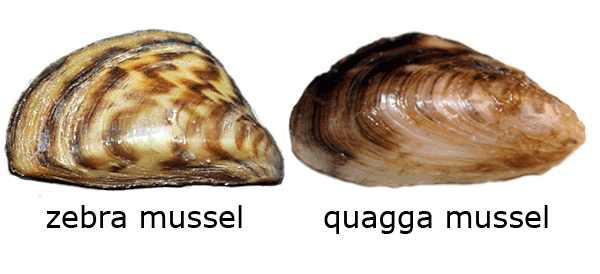
While these species look similar, zebra mussels have a flat side which gives them a distinct “D” shape. Their shell may have a striped pattern, but can vary from a solid dark to a pale appearance. Zebra mussels are typically found in warm, shallow water.
Quagga mussels, on the other hand, do not have the flat side and have dark concentric rings on the shell. Quagga mussels are usually found in cooler, deeper waters.
Both species live three to five years and start reproducing about six months after the larvae become established. A single female zebra or quagga mussel can produce up to one million eggs in a growing season.
Where are they found?
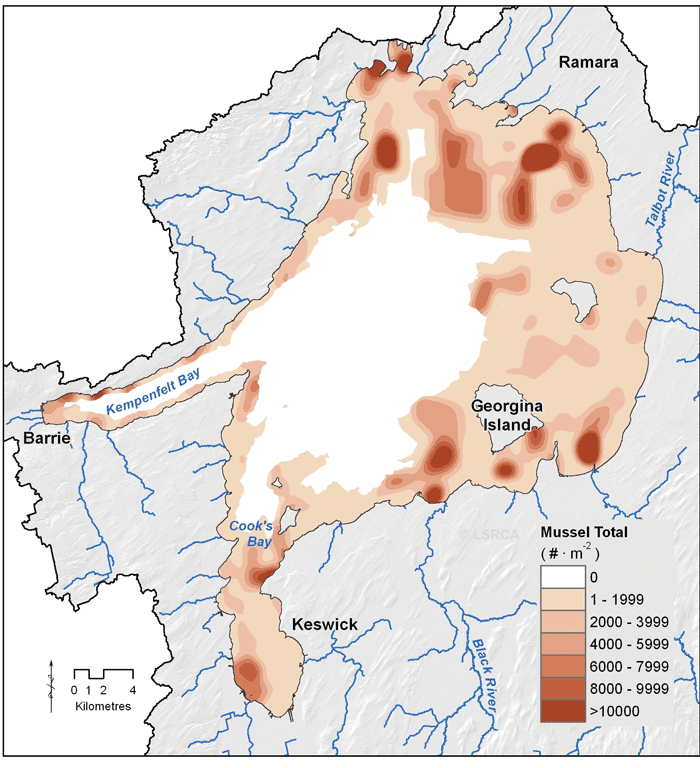
In Lake Simcoe, invasive mussels can be found on rocks, boulders, and sandy/shell lake bottoms. Because zebra mussels tend to live in shallower depths than the quagga mussels, they are the species most often encountered by recreational lake users.
In 2009, LSRCA began surveying 747 sites across Lake Simcoe to determine the distribution of the mussels throughout the lake and their areas of high concentration.
Both zebra and quagga mussels have been recorded as deep as 20 metres in much of Lake Simcoe. Their settlement is restricted by a change in the lake bed composition to soft mud and silt, which clogs their filtering ability, limiting population expansion in these areas.
In Kempenfelt Bay, living zebra and quagga mussels are found as deep as 31 metres; likely surviving on food particles that drift off the steep underwater sides of the bay.
Filtering the Lake
Since 1995, zebra and quagga mussels have caused colossal environmental changes in Lake Simcoe.
Like native mussels, they eat algae and nutrientrich bits of sediment. However, these invaders have an exceptionally high filtering rate, making them very efficient at removing these important particles from the water. In fact, zebra and quagga mussels can filter a volume equivalent to that of Lake Simcoe every five days!
Before their arrival, residents and lake users noted the lake water had a “cloudy, greenish” colour — murky conditions caused by large amounts of algae in the water, common to lakes with high phosphorus concentrations. These particles reduced water clarity in the lake, which prevented sunlight from reaching deep into the water column.
With sunlight now penetrating deeper into the lake, ecological changes have occurred in nutrient flows, food webs, and habitats of more aquatic plants.
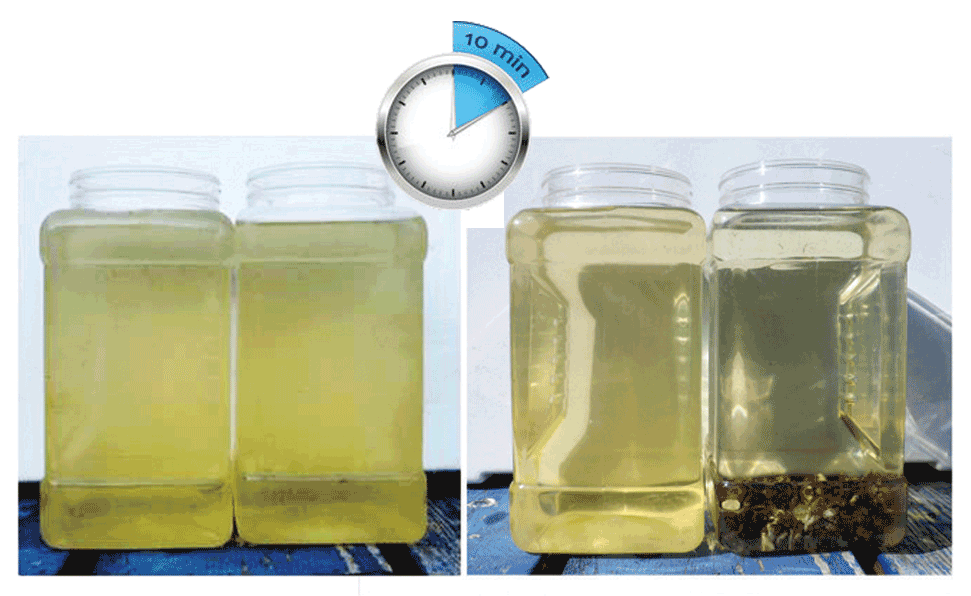
Zebra & quagga mussels change the environment of Lake Simcoe
The pictures show a set of four-litre jars filled with murky, water from the Holland River (left).
Within 10 minutes of the zebra mussels being added one of the jars (far right), the particles that cause the water to be murky have been filtered, leaving it clear.
This simple experiment is a small-scale example of how zebra and quagga mussels have changed the environment of Lake Simcoe.
Invaders tip the ecological balance
Typically, a change from murky water (usually due to high algae growth) to clear water is caused by a decrease in nutrients, such as phosphorus and nitrogen entering the lake. While LSRCA has had success in reducing the amount of phosphorus entering Lake Simcoe, the clear water is primarily due to the zebra and quagga mussels.
With zebra and quagga mussels increasing the clarity of the lake, Lake Simcoe has changed from a nutrient-rich lake (primarily dominated by algae) to a plant-dominated lake.
The removal of algae by these mussels means the excess nutrients that were once taken up by the algae are now fueling the increased aquatic plant growth in the lake.
In addition, large quantities of nutrient-rich waste from zebra mussels is deposited on the lake bottom each day. These “biodeposits” form a nutrient-rich substrate, which combined with increased water clarity, is an ideal environment for aquatic plants.
Since 1984, the population size of aquatic plants has tripled.
Lake clarity increases soon after mussels invade
Water clarity measurements at Brechin Monitoring Station from 1980- 2010. Symbols courtesy of Integration and Application Network (IAN) Symbols and Libraries.
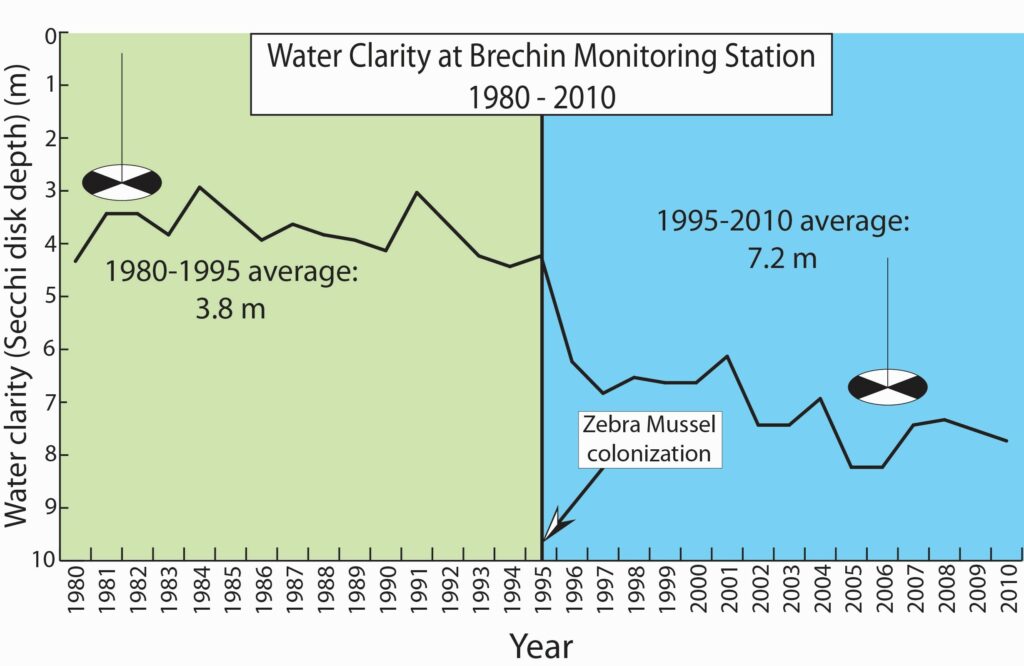
They decrease biodiversity
In addition to changing the natural conditions of Lake Simcoe, zebra and quagga mussels, like other invasive species, have changed the animal community in the lake. Before 1995, Lake Simcoe was home to 16 species of native freshwater mussels and clams.
By 2010, only four species were recorded: zebra mussels, quagga mussels, and very low numbers of two native species which are at high risk for local extinction.
Like other invasive species, zebra and quagga mussels have no natural predators in Lake Simcoe and can increase rapidly in numbers. Also, their ability to quickly filter large amounts of water means they can consume food quicker than native species.
Change from nutrient-rich lake to plant-dominated lake
Conceptual drawing illustrates the change from an algae-dominated, turbid lake to a plant-dominated, clear water lake after mussels invade Lake Simcoe.
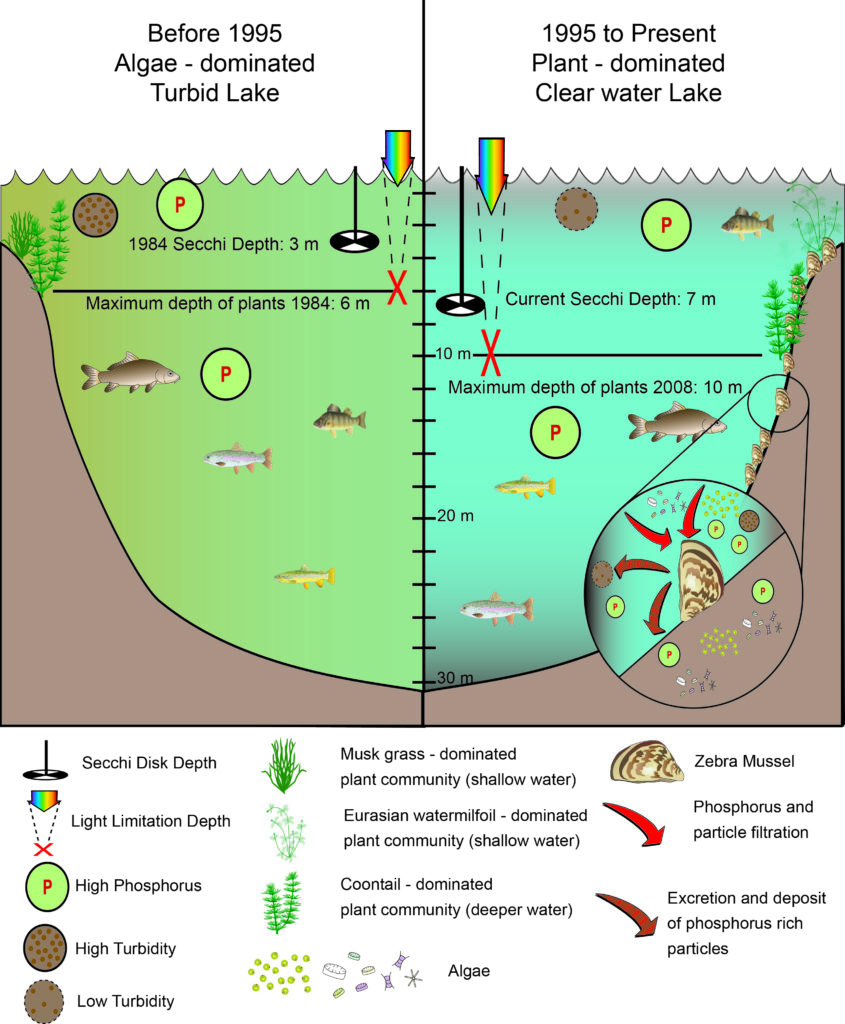
How LSRCA is working to improve the quality of Lake Simcoe
Once an invasive species enters a lake it is almost impossible to eradicate it. However, through our research and monitoring programs, we now have a better understanding of the current lake ecosystem and we can determine what steps we need to take to manage and prevent new invasive species from being introduced to the lake.
As part of our lake monitoring program, we will continue to record how these mussel populations change from year to year, and we’ll monitor for new invasive species in Lake Simcoe.
A few key invasive species on our watch list include Asian (jumping) Carp (now in the Chicago River close to Lake Michigan), bloody red shrimp, and aquatic plants like European water chestnut (currently in several Ontario lakes), water soldier (recorded in 2012 in the Trent-Severn waterway), and fanwort.
We work with our many partners, including our communities, municipal, provincial and federal governments, to protect and restore the environmental health and quality of Lake Simcoe and its watershed. We do this by leading and supporting programs and projects in science and research, protection and restoration, and education and engagement, including:
- Lake and tributary monitoring
- Subwatershed planning
- Development and testing of new tools and innovative technologies for phosphorus reduction
- Working with landowners to implement restoration projects
- Public and youth education
Prevention is the key
You can help by practicing “invasive species prevention”:
- Do not release aquarium pets or plants, into waterways or the lake.
- Clean boats, fishing gear, and waders with hot (at least 50oC) water when moving between lakes
- Drain bilges and live wells
- Dry boats and equipment (zebra mussels can live for 10 days out of water!)
- Do not transport bait or water between lakes
Who to Contact:
Customer Service
Phone: 905-895-1281
Toll Free: 1-800-465-0437
Email: info@LSRCA.on.ca
This newsletter was published in Lake Simcoe Living Magazine in 2013.
